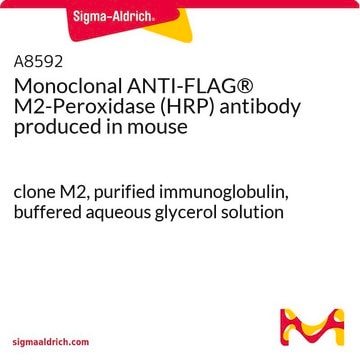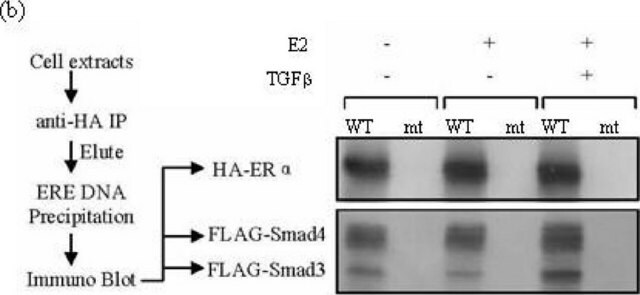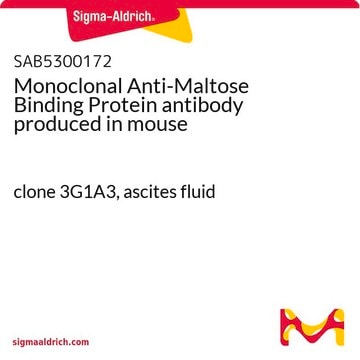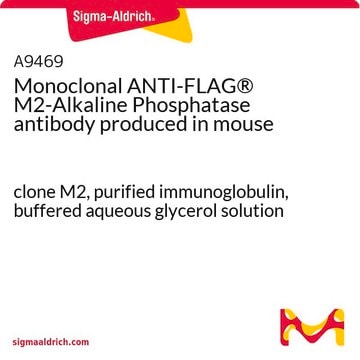The main application for Product F2555 rabbit monoclonal is for immunoblotting after immunoprecipitation with M2, which is a mouse antibody. This enables using a secondary antibody (anti-rabbit) that will not bind the M2 mouse heavy (50 kD) and light chains (25 kD).
F2555
Rabbit Monoclonal ANTI-FLAG® Clone SIGI-25
clone SIG1-25, ascites fluid
Synonyme(s) :
Anti-ddddk, Anti-dykddddk
Sélectionner une taille de conditionnement
502,00 €
Sélectionner une taille de conditionnement
About This Item
502,00 €
Produits recommandés
Source biologique
rabbit
Niveau de qualité
Conjugué
unconjugated
Forme d'anticorps
ascites fluid
Type de produit anticorps
primary antibodies
Clone
SIG1-25, monoclonal
Technique(s)
immunocytochemistry: 1:125-1:250 using transiently transfected cells expressing FLAG (sequence at the N-terminus)-tagged protein fixed with paraformaldehyde/Triton™ X-100
indirect ELISA: suitable
western blot: 1:250-1:500 using extracts of transiently transfected cells expressing FLAG (sequence at the N-terminus)-tagged protein
Isotype
IgG
Séquence immunogène
DYKDDDDK
Conditions d'expédition
dry ice
Température de stockage
−20°C
Catégories apparentées
Description générale
Spécificité
Immunogène
Application
Learn more product details in our FLAG® application portal.
Forme physique
Informations légales
Vous ne trouvez pas le bon produit ?
Essayez notre Outil de sélection de produits.
Code de la classe de stockage
10 - Combustible liquids
Classe de danger pour l'eau (WGK)
WGK 3
Point d'éclair (°F)
Not applicable
Point d'éclair (°C)
Not applicable
Équipement de protection individuelle
Eyeshields, Gloves, multi-purpose combination respirator cartridge (US)
Faites votre choix parmi les versions les plus récentes :
Certificats d'analyse (COA)
Vous ne trouvez pas la bonne version ?
Si vous avez besoin d'une version particulière, vous pouvez rechercher un certificat spécifique par le numéro de lot.
Déjà en possession de ce produit ?
Retrouvez la documentation relative aux produits que vous avez récemment achetés dans la Bibliothèque de documents.
Les clients ont également consulté
Contenu apparenté
Protein and nucleic acid interaction reagents and resources for investing protein-RNA, protein-DNA, and protein-protein interactions and associated applications.
Réactifs pour interactions entre protéines et acides nucléiques, ressources permettant d'étudier les interactions protéines/ARN, protéines/ADN et protéines/protéines, et applications associées.
-
Why should I use Product No. F2555, Monoclonal ANTI-FLAG® antibody produced in rabbit?
1 réponse-
Utile ?
-
-
Is Product F2555 a monoclonal or polyclonal FLAG® antibody?
1 réponse-
F2555 is a monoclonal antibody, raised in rabbits. [Note: Nearly all of the monoclonal antibodies sold by Sigma-Aldrich are raised in mice.]
Utile ?
-
-
What positive controls can be used for immunoblotting with Product F2555, Monoclonal ANTI-FLAG® antibody produced in rabbit - clone SIG1-25?
1 réponse-
Two of the FLAG-tagged proteins offered by Sigma-Aldrich are the Amino-terminal FLAG-BAP fusion protein (Product No. P7582) and the Carboxy-terminal FLAG-BAP fusion protein (Product No. P7457). Both of these proteins should work with the F2555 rabbit ANTI-FLAG.
Utile ?
-
-
What is the Department of Transportation shipping information for this product?
1 réponse-
Transportation information can be found in Section 14 of the product's (M)SDS.To access the shipping information for this material, use the link on the product detail page for the product.
Utile ?
-
-
Will Product No. F2555, Monoclonal ANTI-FLAG® antibody produced in rabbit - clone SIG1-25, recognize an internal FLAG tag protein?
1 réponse-
F2555 will recognize N-terminal and C-terminal FLAG fusion proteins.
Utile ?
-
Filtres actifs
Notre équipe de scientifiques dispose d'une expérience dans tous les secteurs de la recherche, notamment en sciences de la vie, science des matériaux, synthèse chimique, chromatographie, analyse et dans de nombreux autres domaines..
Contacter notre Service technique













